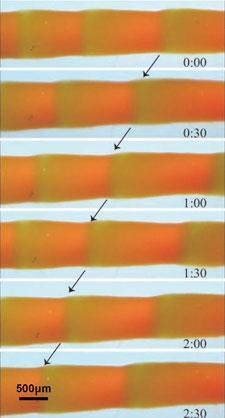Clever oscillating gels carry a cargo
Chemists in Japan have developed an oscillating polymer gel that produces ’waves’ which can push or pumpa cargo along its surface. The polymer, which moves without the need for external control, is step towards miniaturised autonomous pumping systems, which could find many medical applications.
The gel’s secret is an oscillating chemical reaction that causes the polymer structure to repeatedly expand and contract. This produces a ’peristaltic’ motion similar to the muscles that squeeze food in a single direction through the human digestive system.
To make the gel, the team at Waseda University in Tokyo first created a hydrogel from a cross-linked polymer and a ruthenium complex. This was then immersed in a solution to soak up the other components of an oscillating Belousov-Zhabotinsky (BZ) reaction.

The BZ reaction is a favourite in lab demonstrations as an example of a ’chemical clock’ - where a solution switches back and forth between two colours as the reaction proceeds. The reaction is unusual because it does not reach equilibrium - instead, several coupled reactions swing back and forth in waves. Transition metal ions in the solution are continually oxidised and reduced during the reaction, and this is what causes the colour changes.
In the peristaltic gel, the ruthenium ions repeatedly switch their oxidation state between Ru(II) and Ru(III). Since Ru(II) makes the gel less water soluble than Ru(III), the gel responds by periodically swelling and shrinking as the reaction continues.
’By carefully controlling the synthesis conditions, we made the hydrogel form a porous structure that responds very quickly to the BZ reaction,’ says Shingo Maeda, the lead author on the project. ’This was enough to allow us to observe peristaltic motion.’
To demonstrate the potential of their technique, the team showed how the polymer could function like a conveyer belt by pushing a cylindrical object along. Although the gel does not require any external stimuli, such as electrical signals or pH, to continue pumping, the reaction could potentially be switched on or off using light, Maeda says, and investigations are continuing.
This technology could be used to make self-pumping tubes or other useful technologies that may find medical applications. To test this, Maeda plans to develop a ’chemical robot’ which uses the gel for blood vessels and actuators.
’The polymer used for the gels is biocompatible, so this peristaltic motion could potentially be used to make biomedical pumps, as long as the BZ reaction can be safely induced under biological conditions.’ says Xiaosong Wang at the Colour and Polymer Chemistry Department in the University of Leeds, UK.
However, Ron Siegel at the University of Minnesota, US, notes that biomedical applications could be some distance away, as the BZ reaction only lasts a few hours. ’For virtually any conceivable application, you’d prefer chemical sources of energy that are persistently available in the human body, such as ATP or glucose,’ he says. ’Future work will hopefully evolve in this direction.’
Lewis Brindley
Enjoy this story? Spread the word using the ’tools’ menu on the left
References
S Maeda et al, Angew. Chem. Int. Ed., 2008, DOI: 10.1002/anie.200801347






No comments yet